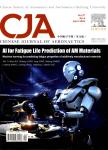Simulative technology for auxiliary fuel tank separation in a wind tunnel
Simulative technology for auxiliary fuel tank separation in a wind tunnel作者机构:Key Laboratory for Precision and Non-traditional Machining Technology of the Ministry of EducationDalian University of Technology
出 版 物:《Chinese Journal of Aeronautics》 (中国航空学报(英文版))
年 卷 期:2016年第29卷第3期
页 面:608-616页
核心收录:
学科分类:08[工学] 080103[工学-流体力学] 082502[工学-航空宇航推进理论与工程] 0802[工学-机械工程] 0825[工学-航空宇航科学与技术] 0801[工学-力学(可授工学、理学学位)]
基 金:co-supported by the National Natural Science Foundation of China(Nos.51375075,51227004) the Special Funds of the National Natural Science Foundation of China(No.51227004) the National Basic Research Program of China(No.2014CB046504) the Fundamental Research Funds for the Central Universities of China the Science Fund for Creative Research Groups of China(No.51321004)
主 题:Aircraft auxiliary equipmentBinocular vision Position and attitude mea-surement Release mechanism Simulation experiment
摘 要:In this paper, we propose a simulative experimental system in wind tunnel conditions lbr the separation of auxiliary fuel tanks from an aircraft. The experimental system consists of a simulative release mechanism, a scaled model and a pose measuring system. A new release mechanism was designed to ensure stability of the separation. Scaled models of the auxiliary fuel tank were designed and their moment of inertia was adjusted by installing counterweights inside the model. Pose param- eters of the scaled model were measured and calculated by a binocular vision system. Additionally, in order to achieve high brightness and high signal-to-noise ratio of the images in the dark enclosed wind tunnel, a new high-speed image acquisition method based on miniature self-emitting units was pre- sented. Accuracy of the pose measurement system and repeatability of the separation mechanism were verified in the laboratory. Results show that the position precision of the pose measurement system can reach 0.1 mm, the precision of the pitch and yaw angles is less than 0.1° and that of the roll angle can be up to 0.3°. Besides, repeatability errors of models" velocity and angular velocity controlled by the release mechanism remain small, satisfying the measurement requirements. Finally, experiments for the separation of auxiliary fuel tanks were conducted in the laboratory.



